Spring AI框架快速入门
- [Spring AI 系列文章:](#Spring AI 系列文章:)
- 一、前言
- 二、源码解析
- 三、自定义MYSQL持久化ChatMemoryRepository
-
- [3.1 自定义结构化数据库](#3.1 自定义结构化数据库)
- [3.2 序列化方式](#3.2 序列化方式)
- 四、持久化到Redis
- 五、总结
Spring AI 系列文章:
【Spring AI 1.0.0】Spring AI 1.0.0框架快速入门(1)------Chat Client API
【Spring AI 1.0.0】Spring AI 1.0.0框架快速入门(2)------Prompt(提示词)
【Spring AI 1.0.0】Spring AI 1.0.0框架快速入门(3)------Structured Output Converter(结构化输出转换器)
【Spring AI 1.0.0】Spring AI 1.0.0框架快速入门(4)------Chat Memory(聊天记录)
一、前言
前一篇文章《【Spring AI 1.0.0】Spring AI 1.0.0框架快速入门(3)------Structured Output Converter(结构化输出转换器)》》中,介绍了Structured Output Converter的基本用法,这篇文章说说什么是聊天记录。
在大型语言模型(LLMs)的架构设计中,其无状态特性导致模型无法保留历史交互信息,这在需要持续维护对话上下文的应用场景中构成了显著限制。针对这一技术瓶颈,Spring AI框架创新性地提出了聊天内存功能,通过实现交互信息的持久化存储与动态检索机制,有效解决了多轮对话中的状态保持问题。
二、源码解析
ChatMemory和ChatMemoryRepository是对话记忆的核心接口
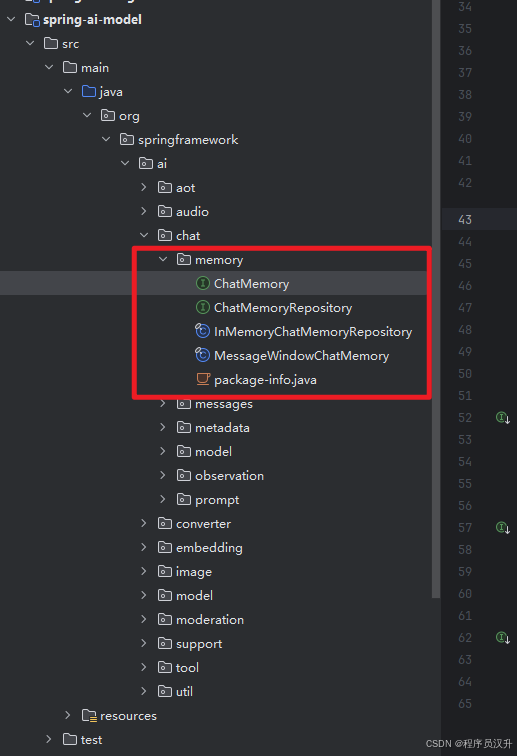
ChatMemory用于短期对话状态管理,它是基于内存的实时操作,有一个实现类MessageWindowChatMemory即活动窗口机制,用于保留最近的N条信息。
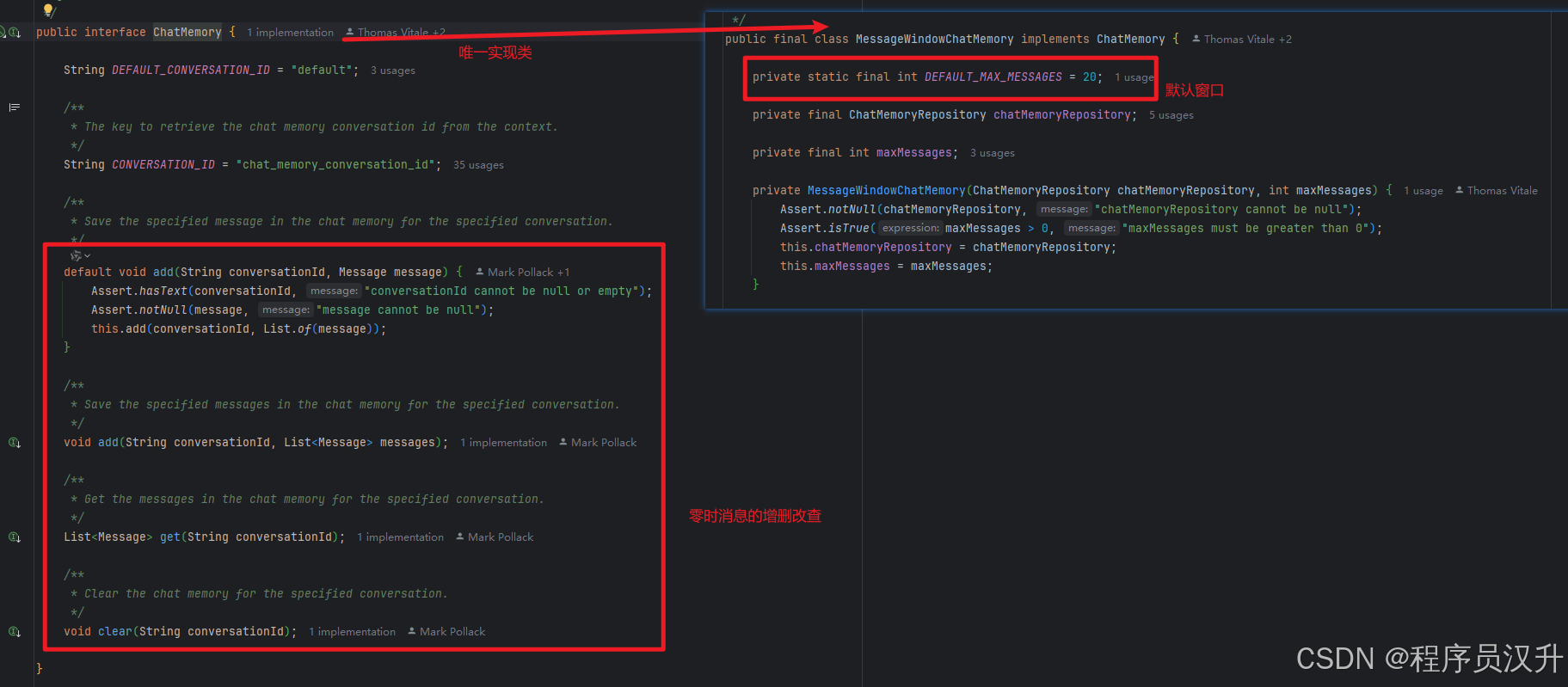
ChatMemoryRepository接口用于长期对话管理,即持久化能力,默认是InMemoryChatMemoryRepository内存缓存,也可以自定方法实现ChatMemoryRepository来持久化到JDBC、MongoDB 等
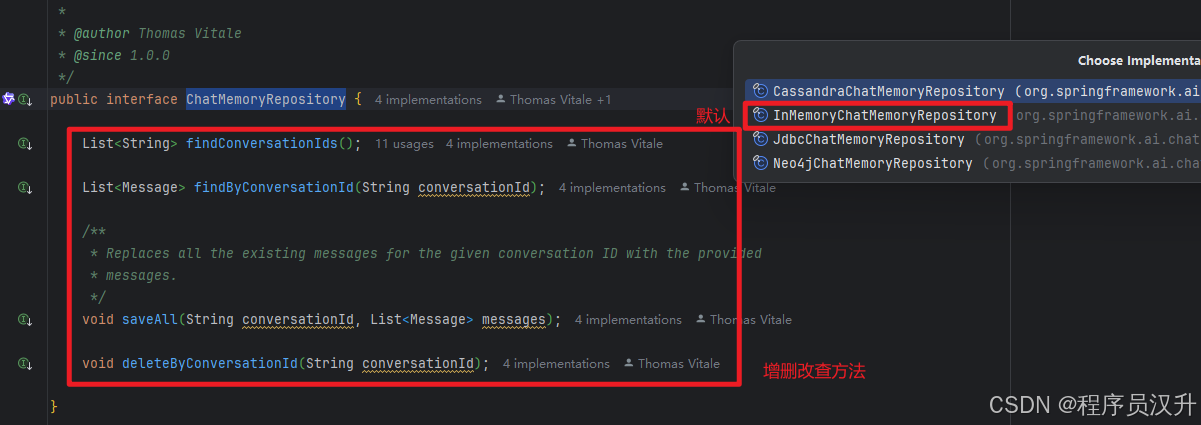
InMemoryChatMemoryRepository的源码,其实就是通过一个ConcurrentHashMap 来维护对话信息,key 是对话 conversationId(相当于房间号),value 是该对话 id 对应的消息列表。
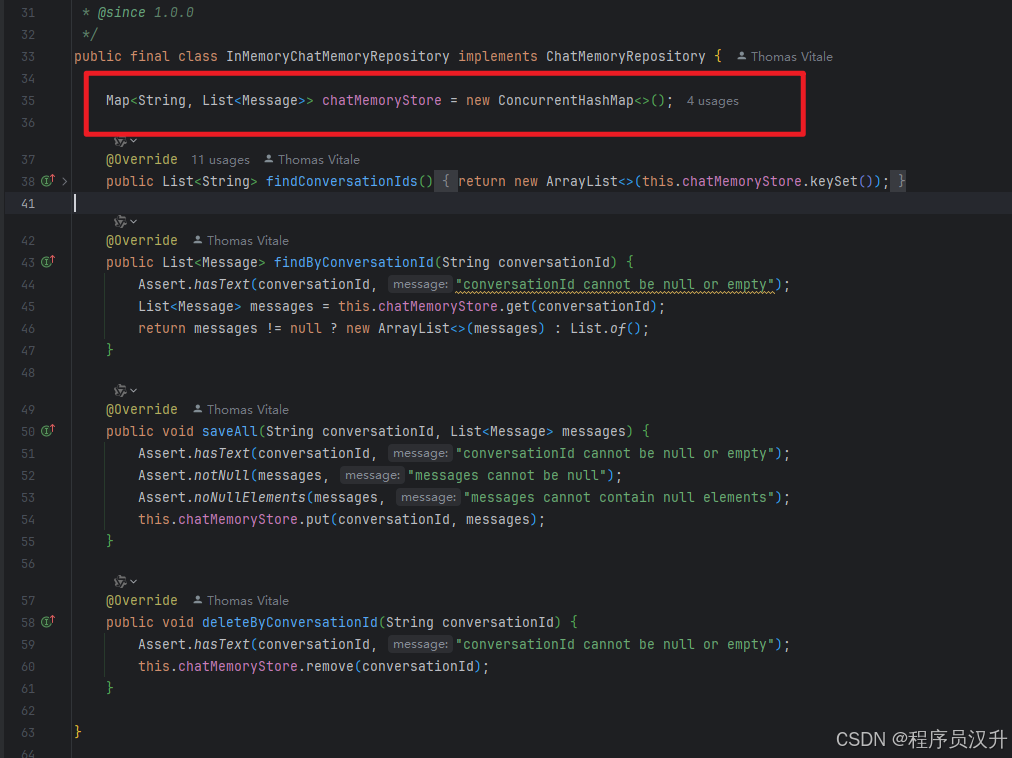
三、自定义MYSQL持久化ChatMemoryRepository
持久化本质是将数据存储到MYSQL中,由于ChatMemoryRepository返回的消息是List<Message>类型,Message是一个接口,虽然实现他的接口不多,实现起来还是有一定的复杂度,最主要的问题是消息和文本的转换。保存消息时,需要将Message对象转换成文本对象;读取消息时,需要将文本对象转换成Message对象。也就是序列化和反序列化。
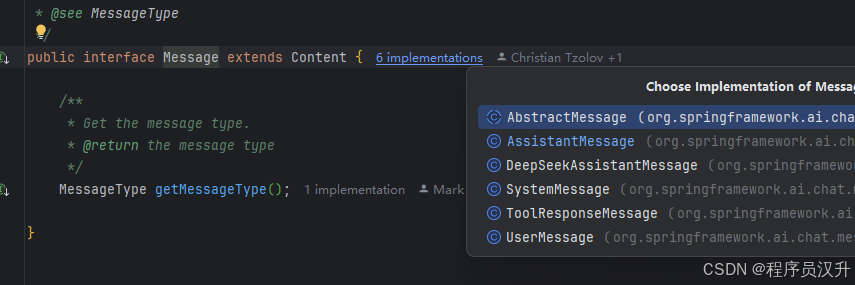
序列化通常采用json,实际并不容易:
- 要持久化的 Message 是一个接口,有很多种不同的子类实现(比如 UserMessage、SystemMessage 等)
- 每种子类所拥有的字段都不一样,结构不统一
- 子类没有无参构造函数,而且没有实现 Serializable 序列化接口
在这里有两个方案:
- 方案一: 自己结构化数据库,使用结构化的数据库然后自己手动创建Message的实现对象来序列化.
- 方案二: 使用序列化库来实现,这里分别尝试了jackson和Kryo序列化库,最终选择了Kryo序列化库,其可以动态注册,减少代码量.
3.1 自定义结构化数据库
maven:
xml
<dependency>
<groupId>org.springframework.ai</groupId>
<artifactId>spring-ai-starter-model-deepseek</artifactId>
</dependency>
<dependency>
<groupId>org.springframework.ai</groupId>
<artifactId>spring-ai-starter-model-zhipuai</artifactId>
</dependency>
<dependency>
<groupId>org.projectlombok</groupId>
<artifactId>lombok</artifactId>
<scope>provided</scope>
</dependency>
<!-- JdbcChatMemoryRepository 是一个内置实现,使用 JDBC 在关系数据库中存储消息。
它开箱即用地支持多个数据库,适合需要持久存储聊天内存的应用程序。-->
<dependency>
<groupId>org.springframework.ai</groupId>
<artifactId>spring-ai-starter-model-chat-memory-repository-jdbc</artifactId>
</dependency>
<dependency>
<groupId>org.springframework.boot</groupId>
<artifactId>spring-boot-starter-webflux</artifactId>
</dependency>
<!-- MySQL 驱动 -->
<dependency>
<groupId>mysql</groupId>
<artifactId>mysql-connector-java</artifactId>
<version>8.0.32</version>
</dependency>
<!-- https://mvnrepository.com/artifact/com.baomidou/mybatis-plus-boot-starter -->
<dependency>
<groupId>com.baomidou</groupId>
<artifactId>mybatis-plus-spring-boot3-starter</artifactId>
<version>3.5.12</version>
</dependency>
<!-- 3.5.9及以上版本想使用mybatis plus分页配置需要单独引入-->
<dependency>
<groupId>com.baomidou</groupId>
<artifactId>mybatis-plus-jsqlparser</artifactId>
<version>3.5.12</version> <!-- 确保版本和 MyBatis Plus 主包一致 -->
</dependency>SQL
sql
CREATE TABLE ai_chat_memory (
id BIGINT AUTO_INCREMENT PRIMARY KEY,
conversation_id VARCHAR(255) NOT NULL comment '会话id',
type VARCHAR(20) NOT NULL comment '消息类型',
content TEXT NOT NULL comment '消息内容',
create_time TIMESTAMP NOT NULL DEFAULT CURRENT_TIMESTAMP comment '创建时间',
update_time TIMESTAMP default CURRENT_TIMESTAMP not null on update CURRENT_TIMESTAMP comment '更新时间',
is_delete tinyint default 0 not null comment '是否删除',
INDEX idx_conv (conversation_id)
) ENGINE=InnoDB DEFAULT CHARSET=utf8mb4;配置:
yaml
#https://doc.spring4all.com/spring-ai/reference/api/chat/deepseek-chat.html
# deepseek ai
spring.ai.chat.client.enabled=false
spring.ai.deepseek.api-key=your api key
#spring.ai.deepseek.base-url=https://api.deepseek.com
spring.ai.deepseek.chat.options.model=deepseek-chat
#spring.ai.deepseek.chat.options.model=deepseek-reasoner
spring.ai.deepseek.chat.options.temperature=0.8
# zhipu ai
spring.ai.zhipuai.api-key=49dadd9c9d504acbb60580f6d53cf30b.vlX0Fp67MTwxdZ5i
spring.ai.zhipuai.base-url=https://open.bigmodel.cn/api/paas
#spring.ai.zhipuai.image.options.model=cogview-3
#spring.ai.zhipuai.image.options.model=embedding-2
spring.ai.zhipuai.chat.options.model=glm-4v-flash
logging.level.org.springframework.ai.chat.client.advisor=DEBUG
# mysql
spring.datasource.url=jdbc:mysql://localhost:3307/ai?useUnicode=true&characterEncoding=utf-8&useSSL=false&serverTimezone=UTC
spring.datasource.username=root
spring.datasource.password=123456
spring.datasource.driver-class-name=com.mysql.cj.jdbc.Driver
# mybatis-plus
mybatis-plus.configuration.map-underscore-to-camel-case=false
mybatis-plus.configuration.log-impl=org.apache.ibatis.logging.stdout.StdOutImpl
# 全局逻辑删除的实体字段名
mybatis-plus.global-config.db-config.logic-delete-field=isDelete
# 逻辑已删除值(默认为 1)
mybatis-plus.global-config.db-config.logic-delete-value=1
# 逻辑未删除值(默认为 0)
mybatis-plus.global-config.db-config.logic-not-delete-value=0实体类:
java
import TableName(value ="ai_chat_memory")
@Data
public class AiChatMemory implements Serializable {
/**
*
*/
@TableId(type = IdType.AUTO)
private Long id;
/**
* 会话id
*/
@TableField("conversation_id")
private String conversationId;
/**
* 消息类型
*/
@TableField("type")
private String type;
/**
* 消息内容
*/
@TableField("content")
private String content;
/**
* 创建时间
*/
@TableField("create_time")
private Date createTime;
/**
* 更新时间
*/
@TableField("update_time")
private Date updateTime;
/**
* 是否删除
*/
@TableLogic
@TableField("is_delete")
private Integer isDelete
}ChatMemoryRepository实现:
java
@Service
public class MyBatisPlusChatMemoryRepository implements ChatMemoryRepository {
@Resource
private AiChatMemoryMapper mapper;
@Override
public List<String> findConversationIds() {
// 查询所有会话的ID
LambdaQueryWrapper<AiChatMemory> lqw = new LambdaQueryWrapper<>();
return mapper.selectList(lqw)
.stream()
.map(AiChatMemory::getConversationId)
.distinct()
.collect(Collectors.toList());
}
@Override
public List<Message> findByConversationId(String conversationId) {
LambdaQueryWrapper<AiChatMemory> lqw = new LambdaQueryWrapper<>();
lqw.eq(AiChatMemory::getConversationId, conversationId);
lqw.orderByDesc(AiChatMemory::getCreateTime);
List<AiChatMemory> aiChatMemories = mapper.selectList(lqw);
List<Message> messages = new ArrayList<>();
for (AiChatMemory aiChatMemory : aiChatMemories) {
String type = aiChatMemory.getType();
switch (type) {
case "user" -> messages.add(new UserMessage(aiChatMemory.getContent()));
case "assistant" -> messages.add(new AssistantMessage(aiChatMemory.getContent()));
case "system" -> messages.add(new SystemMessage(aiChatMemory.getContent()));
default -> throw new IllegalArgumentException("Unknown message type: " + type);
}
}
return messages;
}
@Override
public void saveAll(String conversationId, List<Message> messages) {
List<AiChatMemory> list = new ArrayList<>();
messages.stream().forEach(message -> {
AiChatMemory aiChatMemory = new AiChatMemory();
aiChatMemory.setConversationId(conversationId);
aiChatMemory.setType(message.getMessageType().getValue());
aiChatMemory.setContent(message.getText());
list.add(aiChatMemory);
});
mapper.insertBatch(list);
}
@Override
public void deleteByConversationId(String conversationId) {
// 删除指定会话的所有消息
LambdaQueryWrapper<AiChatMemory> wrapper = new LambdaQueryWrapper<>();
wrapper.eq(AiChatMemory::getConversationId, conversationId);
mapper.delete(wrapper);
}
public List<AiChatMemory> findAiChatMemoryList(String conversationId) {
LambdaQueryWrapper<AiChatMemory> lqw = new LambdaQueryWrapper<>();
lqw.eq(AiChatMemory::getConversationId, conversationId);
lqw.orderByDesc(AiChatMemory::getCreateTime);
return mapper.selectList(lqw);
}
}核心代码实现:
java
@Slf4j
@Service
public class ChatService {
@Resource(name = "zhiPuAiChatClient")
private ChatClient chatClient;
@Resource
private MyBatisPlusChatMemoryRepository chatMemoryRepository;
private final Map<String, ChatMemory> memoryMap = new ConcurrentHashMap<>();
public Flux<String> chat(String conversationId, String message) {
ChatMemory chatMemory = this.getMemory(conversationId);
// 添加用户消息
UserMessage userMessage = new UserMessage(message);
chatMemory.add(conversationId, userMessage);
chatMemoryRepository.saveAll(conversationId, List.of(userMessage));
// 构建包含上下文的Prompt
List<Message> messages = chatMemory.get(conversationId);
// 调用ChatClient的流式接口
Flux<String> responseStream = chatClient.prompt(new Prompt(messages))
.stream()
.content();
// 使用StringBuilder累积完整响应
StringBuilder fullResponse = new StringBuilder();
return responseStream
// 每收到一个流片段就追加到StringBuilder
.doOnNext(chunk -> fullResponse.append(chunk))
// 当流完成时,异步保存完整响应
.doOnComplete(() -> {
// 使用异步线程执行保存操作,避免阻塞流处理
Mono.fromRunnable(() -> {
String output = fullResponse.toString();
log.warn("AI Response: {}", output);
AssistantMessage assistantMessage = new AssistantMessage(output);
chatMemory.add(conversationId, assistantMessage);
chatMemoryRepository.saveAll(conversationId, List.of(assistantMessage));
})
.subscribeOn(Schedulers.boundedElastic())
.subscribe(); // 订阅以触发异步执行
});
}
public List<AiChatMemory> getHistory(String conversationId) {
return chatMemoryRepository.findAiChatMemoryList(conversationId);
}
private ChatMemory getMemory(String conversationId) {
return memoryMap.computeIfAbsent(conversationId, id -> MessageWindowChatMemory.builder().build());
}
}上述代码中使用ConcurrentHashMap()来管理当前的会话记录,key为conversationId,value为ChatMemory,将当前消息和历史消息整合成Prompt,然后通过chatClient.prompt()来调用大模型,使用stream(),来流式返回。最后通过StringBuilder fullResponse来异步接收完整的答案,最后保存到数据库中。
接口:
java
@RestController
@RequiredArgsConstructor
@RequestMapping("/api/chat")
public class ChatMemoryController {
@Resource
private ChatService chatService;
@GetMapping("/history")
public List<AiChatMemory> history(@RequestParam String conversationId) {
return chatService.getHistory(conversationId);
}
@GetMapping(value = "/testMysqlChatMemory", produces = "text/html;charset=UTF-8")
Flux<String> testMysqlChatMemory(@RequestParam String conversationId, @RequestParam String message) {
return chatService.chat(conversationId, message);
}
}执行结果:
可以看到应答是流式出来的
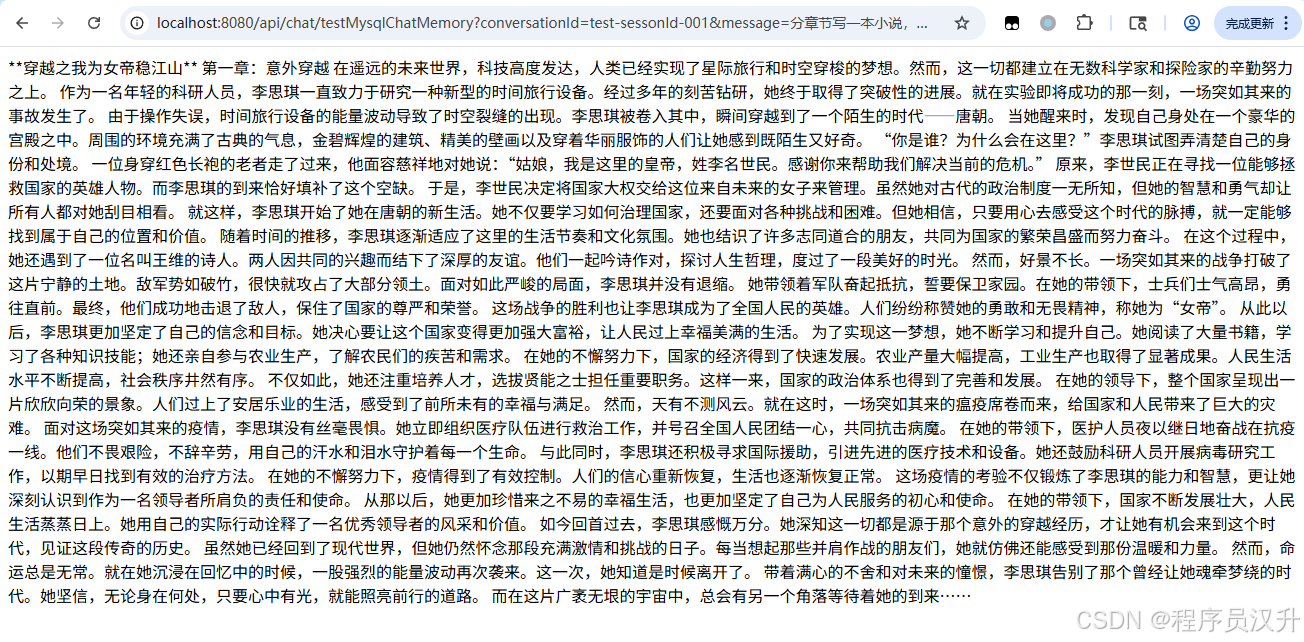
表中有了这一条数据

然后接着执行:
http://localhost:8080/api/chat/testMysqlChatMemory?conversationId=test-sessonId-001&message=继续写第二章
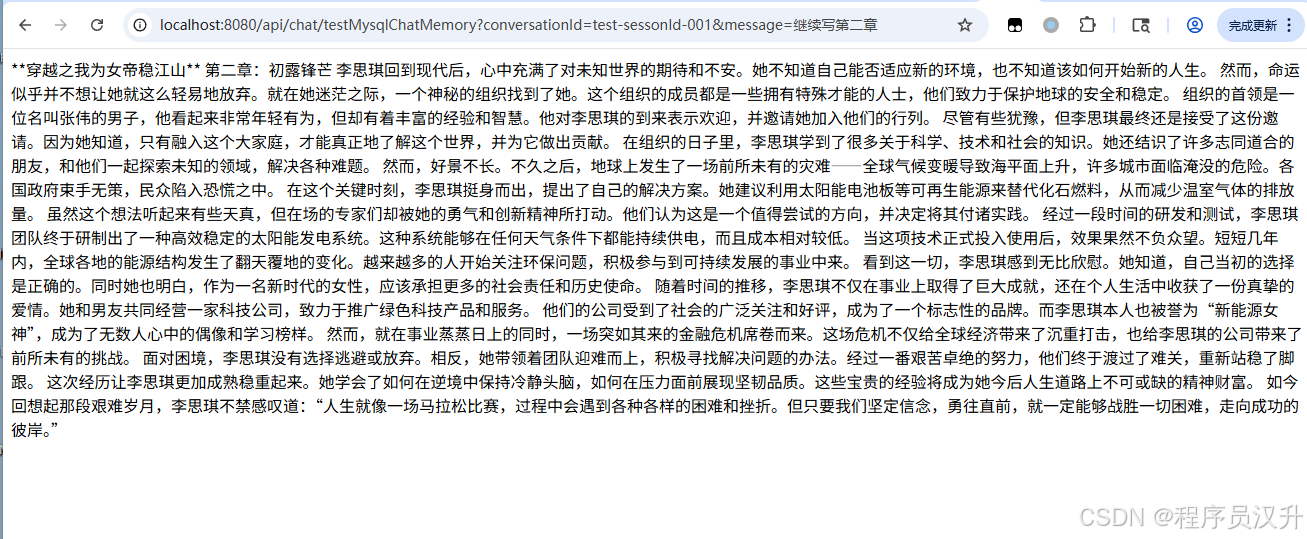
数据库表中新增数据:

3.2 序列化方式
先创建数据库表:
sql
DROP TABLE IF EXISTS logger;
create table logger
(
id varchar(255) not null,
userId bigint not null,
message text not null,
time datetime default CURRENT_TIMESTAMP not null
);
DROP TABLE IF EXISTS request;
create table request
(
id varchar(255) not null,
userId bigint not null,
name varchar(255) not null
);#会话
DROP TABLE IF EXISTS user;
create table user
(
id bigint not null
primary key,
name varchar(255) not null,
status tinyint not null comment '用户身份
0 - 无ai权限
1 - 有ai权限'
);引入相关依赖:
xml
<!-- 自定义持久化的序列化库-->
<dependency>
<groupId>com.esotericsoftware</groupId>
<artifactId>kryo</artifactId>
<version>5.6.2</version>
</dependency>创建序列化工具类:
java
@Component
public class MessageSerializer {
// ⚠️ 静态 Kryo 实例(线程不安全,建议改用局部实例)
private static final Kryo kryo = new Kryo();
static {
kryo.setRegistrationRequired(false);
// 设置实例化策略(需确保兼容所有 Message 实现类)
kryo.setInstantiatorStrategy(new StdInstantiatorStrategy());
}
/**
* 使用 Kryo 将 Message 序列化为 Base64 字符串
*/
public static String serialize(Message message) {
try (ByteArrayOutputStream baos = new ByteArrayOutputStream();
Output output = new Output(baos)) {
kryo.writeClassAndObject(output, message); // ⚠️ 依赖动态注册和实例化策略
output.flush();
return Base64.getEncoder().encodeToString(baos.toByteArray());
} catch (IOException e) {
throw new RuntimeException("序列化失败", e);
}
}
/**
* 使用 Kryo 将 Base64 字符串反序列化为 Message 对象
*/
public static Message deserialize(String base64) {
try (ByteArrayInputStream bais = new ByteArrayInputStream(Base64.getDecoder().decode(base64));
Input input = new Input(bais)) {
return (Message) kryo.readClassAndObject(input); // ⚠️ 依赖动态注册和实例化策略
} catch (IOException e) {
throw new RuntimeException("反序列化失败", e);
}
}
}创建自定义的数据库持久化ChatMemoryRepository:
java
@Service
@Slf4j
public class SerializerMethodChatMemory implements ChatMemoryRepository {
@Resource
private LoggerMapper loggerMapper;
@Override
public List<String> findConversationIds() {
QueryWrapper<Logger> wrapper = new QueryWrapper<>();
List<Logger> loggerList = loggerMapper.selectList(wrapper);
return loggerList.stream()
.map(Logger::getId)
.distinct()
.collect(Collectors.toList());
}
@Override
public List<Message> findByConversationId(String conversationId) {
Long userId = parseUserId(conversationId);
QueryWrapper<Logger> wrapper = new QueryWrapper<>();
wrapper.eq("id", conversationId)
.eq("userId", userId) // 添加用户 ID 过滤
.orderByDesc("time"); // 按时间倒序
List<Logger> loggerList = loggerMapper.selectList(wrapper);
List<Message> messages = new ArrayList<>();
for (Logger logger : loggerList) {
messages.add(MessageSerializer.deserialize(logger.getMessage()));
}
return messages;
}
/**
* 添加多条数据到数据库中
*
* @param conversationId
* @param messages
*/
@Override
public void saveAll(String conversationId, List<Message> messages) {
Long userId = parseUserId(conversationId);
List<Logger> loggerList = new ArrayList<>();
for (Message message : messages) {
Logger logger = new Logger();
logger.setId(conversationId);
logger.setUserId(userId);
logger.setTime(LocalDateTime.now());
logger.setMessage(MessageSerializer.serialize(message));
loggerList.add(logger);
}
loggerMapper.insert(loggerList);
}
@Override
public void deleteByConversationId(String conversationId) {
Long userId = parseUserId(conversationId);
QueryWrapper<Logger> loggerQueryWrapper = new QueryWrapper<>();
loggerQueryWrapper.eq("id", conversationId);
loggerMapper.deleteById(loggerQueryWrapper);
}
// 从 conversationId 解析用户 ID(格式:chat-{userId})
private long parseUserId(String conversationId) {
String[] parts = conversationId.split("-");
if (parts.length == 2 && "chat".equals(parts[0])) {
return Long.parseLong(parts[1]);
}
throw new IllegalArgumentException("无效的 conversationId 格式: " + conversationId);
}
public List<Logger> findAiChatMemoryList(String conversationId) {
LambdaQueryWrapper<Logger> lqw = new LambdaQueryWrapper<>();
lqw.eq(Logger::getUserId, parseUserId(conversationId));
lqw.orderByDesc(Logger::getTime);
return loggerMapper.selectList(lqw);
}
}核心接口和上面类似,我们直接执行来看效果:
浏览器执行:
http://localhost:8080/api/chat/test/serializer?conversationId=chat-000000001&message=解说一下成龙的一部电影

查表可知内容数据被序列化成了特殊字符

调用查询接口
http://localhost:8080/api/chat/history/serializer?conversationId=chat-000000001
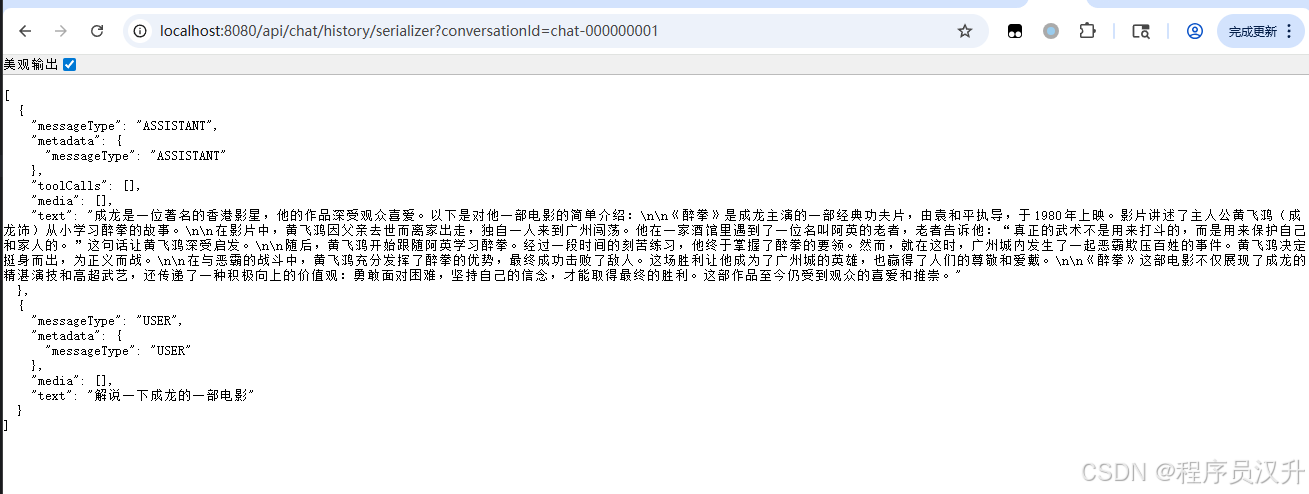
表中的数据又被序列化成了Message对象
四、持久化到Redis
上述代码中,我们讲了通过Kryo来序列化List<Message>对象,这同样可以适用于redis中
引入redis依赖
xml
<!-- Redis -->
<dependency>
<groupId>org.springframework.boot</groupId>
<artifactId>spring-boot-starter-data-redis</artifactId>
</dependency>配置文件:
yaml
spring.data.redis.port=6379
spring.data.redis.host=localhost
spring.data.redis.database=0redis配置类:
java
@Configuration
public class RedisTemplateConfig {
@Bean
public RedisTemplate<String, Object> redisTemplate(RedisConnectionFactory connectionFactory) {
RedisTemplate<String, Object> template = new RedisTemplate<>();
template.setConnectionFactory(connectionFactory);
template.setKeySerializer(RedisSerializer.string());
return template;
}
}实现自定义RedisChatMemory
java
@Service
@Slf4j
public class RedisChatMemory implements ChatMemoryRepository {
@Resource
private RedisTemplate<String, Object> redisTemplate;
// 用于存储所有对话ID的键
private static final String CONVERSATION_IDS_KEY = "ALL_CONVERSATION_IDS";
// 用于JSON序列化/反序列化
private static final ObjectMapper objectMapper = new ObjectMapper();
@Override
public List<String> findConversationIds() {
// 从Redis的集合中获取所有对话ID
Set<Object> members = redisTemplate.opsForSet().members(CONVERSATION_IDS_KEY);
if (members == null || members.isEmpty()) {
return Collections.emptyList();
}
return members.stream()
.map(Object::toString)
.collect(Collectors.toList());
}
@Override
public List<Message> findByConversationId(String conversationId) {
return getFromRedis(conversationId);
}
@Override
public void saveAll(String conversationId, List<Message> messages) {
if (messages.isEmpty()) {
return;
}
List<Message> messageList = getFromRedis(conversationId);
messageList.addAll(messages);
// 保存消息列表
setToRedis(conversationId, messageList);
// 将对话ID添加到集合中(自动去重)
redisTemplate.opsForSet().add(CONVERSATION_IDS_KEY, conversationId);
}
@Override
public void deleteByConversationId(String conversationId) {
// 删除对话消息
redisTemplate.delete(conversationId);
// 从集合中移除对话ID
redisTemplate.opsForSet().remove(CONVERSATION_IDS_KEY, conversationId);
}
/**
* 从Redis获取数据工具方法
* @param conversationId
* @return
*/
private List<Message> getFromRedis(String conversationId) {
Object obj = redisTemplate.opsForValue().get(conversationId);
List<Message> messageList = new ArrayList<>();
if (obj != null) {
try {
// 将obj转换为List<String>
List<String> messageJsons = objectMapper.convertValue(obj, new TypeReference<List<String>>() {});
// 逐个反序列化为Message对象
for (String json : messageJsons) {
Message message = MessageSerializer.deserialize(json);
messageList.add(message);
}
} catch (IllegalArgumentException e) {
log.error("Failed to convert Redis value to List<String>", e);
}
}
return messageList;
}
/**
* 将数据存入Redis工具方法
* @param conversationId
* @param messages
*/
private void setToRedis(String conversationId,List<Message> messages){
List<String> stringList = new ArrayList<>();
for (Message message : messages) {
String serialize = MessageSerializer.serialize(message);
stringList.add(serialize);
}
redisTemplate.opsForValue().set(conversationId,stringList);
}
}核心代码还是比较简单,使用CONVERSATION_IDS_KEY 来存所有的会话id,使用Kryo来序列化数据
来看执行结果:
http://localhost:8080/api/chat/test/redis?conversationId=test-sessonId-001&message=讲一下你最喜欢的小说

redis中的数据:
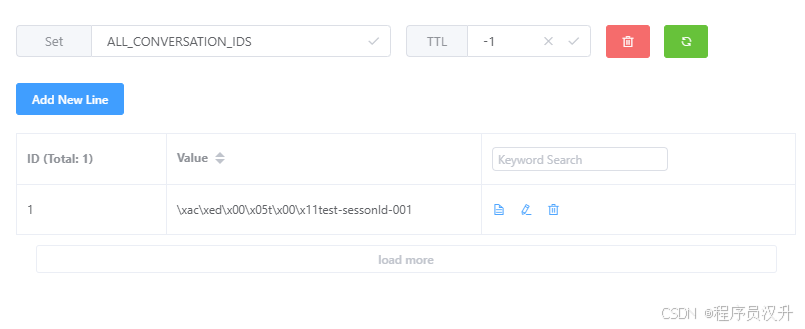
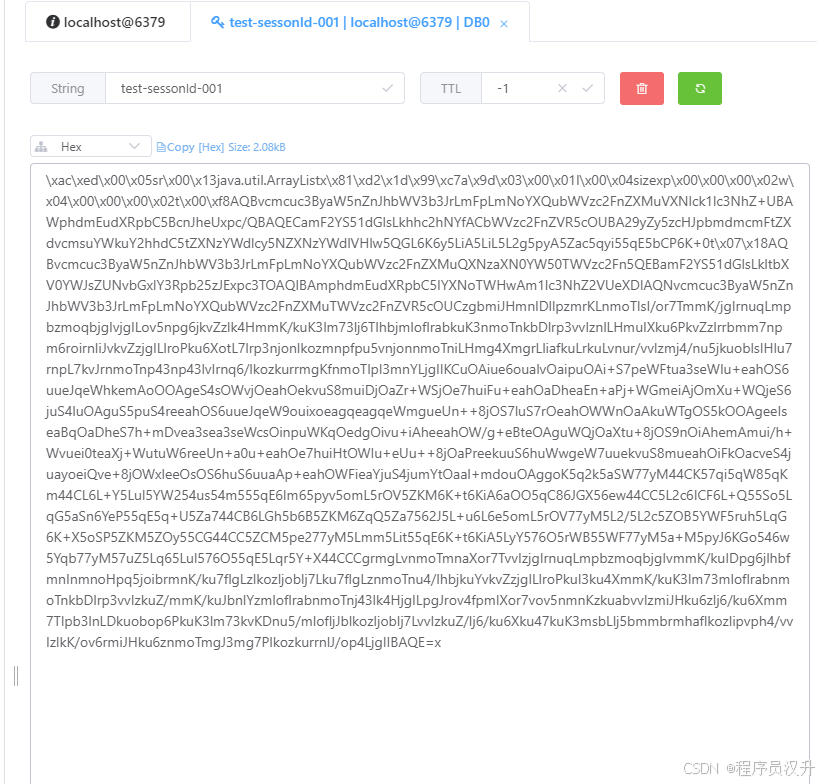
获取结果看看:
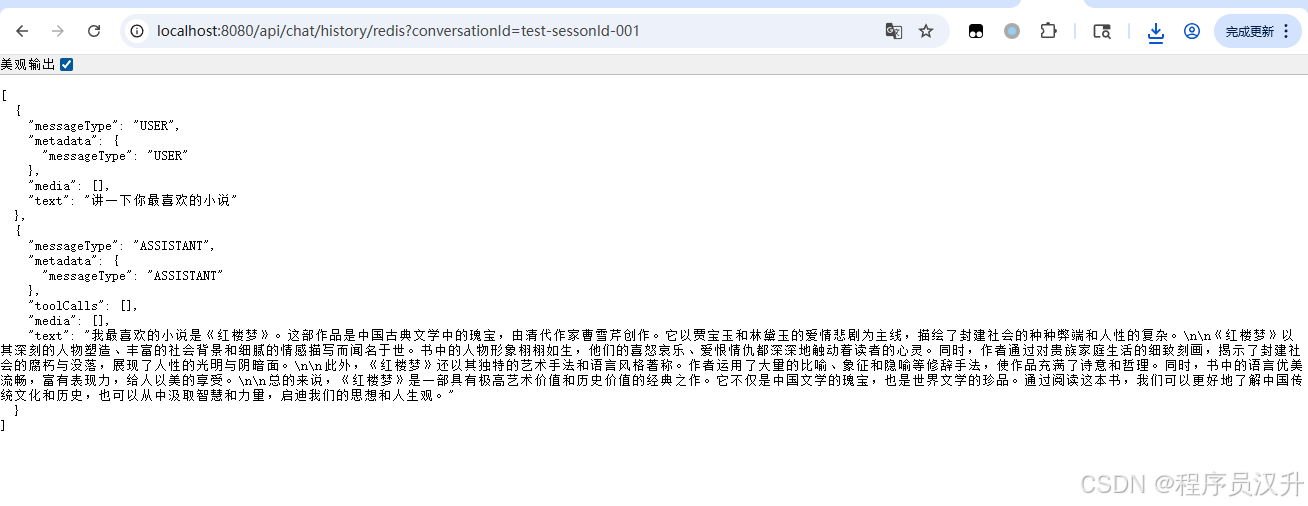
又被反序列化成List<Message>对象
五、总结
这篇文章深入讲解了Spring Ai 1.0.0中Chat Memory(聊天记录)功能,介绍了如何上下文流式交互应答,介绍了通过实现ChatMemoryRepository自定义持久化数据到MySQL和Redis,下篇文章,介绍Spring Ai 中 工具调用
创作不易,不妨点赞、收藏、关注支持一下,各位的支持就是我创作的最大动力❤️

